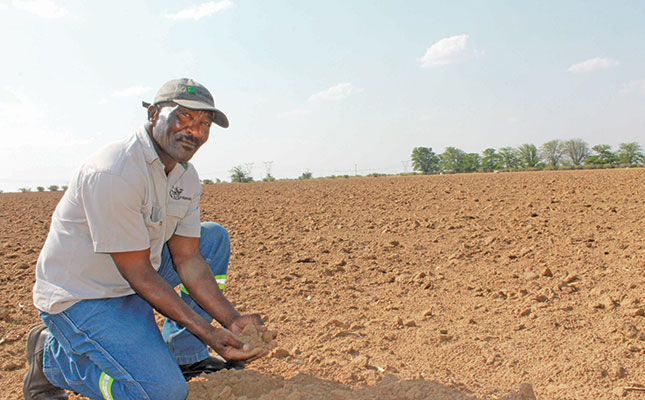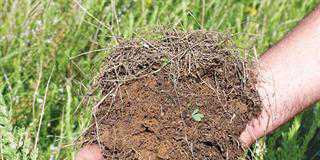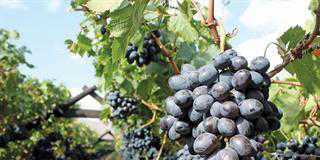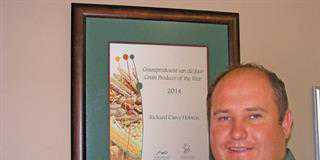
Photo: By Siyanda Sishuba
Free State farmer Paulus Mosia grew up on the farm Vryheid in the Edenville district with his parents and nine siblings. His father, Jonas, worked here as a farmworker and his mother, Maria, as a housekeeper.
His parents were later able to start farming on their own on communal land, and after Mosia matriculated and relocated to Welkom, where he worked on the mines, he used some of his salary to buy cattle to keep on his parents’ land.
In 2005, when he heard about an opportunity to apply for access to land through the former Department of Agriculture, Forestry and Fisheries’ (agriculture department) Proactive Land Acquisition Strategy programme, he submitted an application.
This was finally approved three years later, and he was granted access to lease the 200ha farm Sterkwater, which has 60ha of arable land and 140ha of grazing. Subsequently, he also leasesd an additional 200ha from neighbouring farmers, of which 82ha are planted to crops and 118ha are used for grazing.
Farmer development
Mosia and his wife Namosonto, who runs a 300-chicken broiler business on the farm, are active members of the Edenville Maize Study Group.
Nomasonto was also instrumental in setting up a new study group in Heilbron, which is now part of the Grain SA Farmer Development Programme. Both say that participating in this
programme has changed their lives for the better.
Mosia is a member of the Bemifa Co-operative, which was formed in collaboration with neighbouring farmers with the assistance of US-headquartered company Gen X and support from US Agency for International Development.
Through this programme, farmers receive animal management training and are assisted with buying inputs collectively to obtain discounted bulk rates.
Setting up the farm
Mosia explains that with financial assistance he was able to formally begin his farming
operation. When he arrived on the farm, he had no implements or equipment and there was little infrastructure. Fortunately, there was a good supply of water, thanks to a dam and boreholes with generator-driven pumps.
He started out with only 13 cows, one bull and seven sheep, as well as some vegetable
crops that he sold on the informal market.
In 2013, he began experimenting with grain and oilseed crops, planting soya beans, sunflower, sorghum and maize to ascertain which of these would perform best on his land.
His reliance on leased equipment made it difficult for him to expand grain and oilseed
plantings, so in 2015 he applied for a grant from the former department of agriculture’s
Recapitalisation and Development Programme, through which he was granted R2,1 million.
He used these funds to build a storage facility and purchased a tractor, trailer, boomsprayer, planter, ripper, compressor and generator. He also bought a solar panel that he used to power a water pump.
With no money left to build a small house for him and his wife, they had to make do with a
shack, but Mosia says that if the land belonged to him, he would consider working towards being able to invest in building a house on the farm.
Thanks to additional support from the agriculture department, his cattle herd has grown to 37 animals and he now has 21 sheep. Livestock are sold ad hoc to pay salaries and cover other farm expenses.
Production growth
After conducting a few experiments, Mosia finally settled on a maize and sunflower rotation system. With the help of his mentor, Francois Fivaz, who is also a farmer and owns the co-operative Elvico Boerdery in Edenville, Mosia has increased his sunflower plantings from 8,6ha in 2013/2014 to 80ha in 2019/2020.
He achieves a 1,55t/ ha yield with sunflower, but due to the recent drought and late-season rains in the Free State, his 2019/2020 crop produced only 0,3t/ha.
In 2018/2019, he planted maize for the first time on 160ha, some of which was on leased land, and achieved an average yield of 3,2t/ ha. In 2019/2020, he was unable to lease land and planted only 50ha of maize on his own land. He achieved 5,2t/ ha, in line with the average yield for the area, which ranges between 4,5t/ha and 6t/ha.
Mosia says his yield improved because he took better care of his crop, making use of the
correct fertilisers and planting better-quality seed. The crop also benefitted from more rainfall than during the previous season.
Planting
After harvesting from June to August, livestock is brought in to feed on the maize residue.
Before planting, Mosia prepares the soil in time so that he is not late for the season. Soil
preparation usually starts after the first rain, but, according to Mosia, rainfall has been erratic of late.
“Climate change is a challenge. Normally, rain in this area comes at the end of August and lasts until the end of our planting season in March, but these last few years rainfall has been very unpredictable and the first rains now arrive only at the end of October. To produce a good maize crop in our area, you need to be finished with planting by 16 December,” he says.
Before planting, he rips and discs the soil to break up any compaction and then uses a cultivator to level the soil. His soils tend to be acidic, with a pH level of between 3,9 and 4,2, so he applies liming to obtain a pH of between 5 and 6.
He plants Roundup Ready maize seed from Dekalb at a population of 16 000 kernels/ha at a depth of 3cm. Hemaintains an inter-row spacing of 45cm.
He also plants Dekalb’s DKC73-55R, a non-insect-resistant cultivar, as a refuge crop to slow down insect resistance. Mosia encourages new farmers to consult with seed companies before planting so that they can receive seed recommendations based on the area where they farm.
“It’s important to do research about the seeds you choose to plant and to take into consideration the climate in your area, because you won’t get the same results from the same seed on two different farms,” he says.
When maize is at the eight-leaf stage, about 60 days after planting, he applies fertiliser containing nitrogen, phosphorus, zinc and sulphur at a rate of 200kg/ha. He follows a set weed and pest control management plan recommended by agronomic specialists to control broadleaf weeds and grasses and to protect the crop against pests such as stalk borer.
Mosia does not own his own combine harvester or transport truck, so these have to be hired during harvest. One of his main challenges is the risk of hail damage, which requires
having crop insurance.
He feels this is expensive, especially as 100% cover is unavailable.
Another challenge is maize and stock theft, which he believes is committed by people from a nearby community.
Email Paulus Mosia at [email protected].













